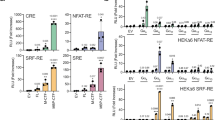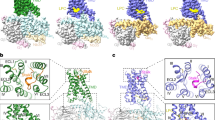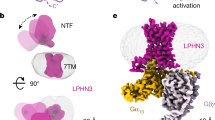Abstract
DdCAD-1 is a novel Ca2+-dependent cell adhesion molecule that lacks a hydrophobic signal peptide and a transmembrane domain. DdCAD-1 is expressed by the social amoeba Dictyostelium discoideum at the onset of development. It is synthesized as a soluble protein and then transported to the plasma membrane by contractile vacuoles. Here we describe the novel features of the solution structures of Ca2+-free and Ca2+-bound monomeric DdCAD-1. DdCAD-1 contains two β-sandwich domains, belonging to the βγ-crystallin and immunoglobulin fold classes, respectively. Whereas the N-terminal domain has a major role in homophilic binding, the C-terminal domain tethers the protein to the cell membrane. From structural and mutational analyses, we propose a model for the Ca2+-bound DdCAD-1 dimer as a basis for understanding DdCAD-1–mediated cell-cell adhesion at the molecular level. Our results provide new insights into Ca2+-dependent mechanisms for cell-cell adhesion.
This is a preview of subscription content, access via your institution
Access options
Subscribe to this journal
Receive 12 print issues and online access
$189.00 per year
only $15.75 per issue
Buy this article
- Purchase on Springer Link
- Instant access to full article PDF
Prices may be subject to local taxes which are calculated during checkout





Similar content being viewed by others
References
Bowers-Morrow, V.M., Ali, S.O. & Williams, K.L. Comparison of molecular mechanisms mediating cell contact phenomena in model developmental systems: an exploration of universality. Biol. Rev. Camb. Philos. Soc. 79, 611–642 (2004).
Baldauf, S.L., Roger, A.J., Wenk-Siefert, I. & Doolittle, W.F. A kingdom-level phylogeny of eukaryotes based on combined protein data. Science 290, 972–977 (2000).
Baldauf, S.L. & Doolittle, W.F. Origin and evolution of the slime molds (Mycetozoa). Proc. Natl. Acad. Sci. USA 94, 12007–12012 (1997).
Coates, J.C. & Harwood, A.J. Cell-cell adhesion and signal transduction during Dictyostelium development. J. Cell Sci. 114, 4349–4358 (2001).
Siu, C-H., Harris, T.J., Wang, J. & Wong, E. Regulation of cell-cell adhesion during Dictyostelium development. Semin. Cell Dev. Biol. 15, 633–641 (2004).
Beug, H., Katz, F.E. & Gerisch, G. Dynamics of antigenic membrane sites relating to cell aggregation in Dictyostelium discoideum. J. Cell Biol. 56, 647–658 (1973).
Brar, S.K. & Siu, C-H. Characterization of the cell adhesion molecule gp24 in Dictyostelium discoideum. Mediation of cell-cell adhesion via a Ca2+-dependent mechanism. J. Biol. Chem. 268, 24902–24909 (1993).
Kamboj, R.K., Gariepy, J. & Siu, C-H. Identification of an octapeptide involved in homophilic interaction of the cell adhesion molecule gp80 of Dictyostelium discoideum. Cell 59, 615–625 (1989).
Wang, J. et al. The membrane glycoprotein gp150 is encoded by the lagC gene and mediates cell-cell adhesion by heterophilic binding during Dictyostelium development. Dev. Biol. 227, 734–745 (2000).
Yang, C., Brar, S.K., Desbarats, L. & Siu, C-H. Synthesis of the Ca(2+)-dependent cell adhesion molecule DdCAD-1 is regulated by multiple factors during Dictyostelium development. Differentiation 61, 275–284 (1997).
Wong, E.F., Brar, S.K., Sesaki, H., Yang, C. & Siu, C-H. Molecular cloning and characterization of DdCAD-1, a Ca2+-dependent cell-cell adhesion molecule, in Dictyostelium discoideum. J. Biol. Chem. 271, 16399–16408 (1996).
Sesaki, H., Wong, E.F. & Siu, C-H. The cell adhesion molecule DdCAD-1 in Dictyostelium is targeted to the cell surface by a nonclassical transport pathway involving contractile vacuoles. J. Cell Biol. 138, 939–951 (1997).
Wong, E. et al. Disruption of the gene encoding the cell adhesion molecule DdCAD-1 leads to aberrant cell sorting and cell-type proportioning during Dictyostelium development. Development 129, 3839–3850 (2002).
Alattia, J.R. et al. Lateral self-assembly of E-cadherin directed by cooperative calcium binding. FEBS Lett. 417, 405–408 (1997).
Pearl, F. et al. The CATH Domain Structure Database and related resources Gene3D and DHS provide comprehensive domain family information for genome analysis. Nucleic Acids Res. 33, D247–D251 (2005).
Holm, L. & Sander, C. Touring protein fold space with Dali/FSSP. Nucleic Acids Res. 26, 316–319 (1998).
Bagby, S., Harvey, T.S., Eagle, S.G., Inouye, S. & Ikura, M. Structural similarity of a developmentally regulated bacterial spore coat protein to beta gamma-crystallins of the vertebrate eye lens. Proc. Natl. Acad. Sci. USA 91, 4308–4312 (1994).
Boggon, T.J. et al. C-cadherin ectodomain structure and implications for cell adhesion mechanisms. Science 296, 1308–1313 (2002).
Inouye, M., Inouye, S. & Zusman, D.R. Biosynthesis and self-assembly of protein S, a development-specific protein of Myxococcus xanthus. Proc. Natl. Acad. Sci. USA 76, 209–213 (1979).
Wenk, M. et al. The domains of protein S from Myxococcus xanthus: structure, stability and interactions. J. Mol. Biol. 286, 1533–1545 (1999).
Dominguez, C., Boelens, R. & Bonvin, A.M. HADDOCK: a protein-protein docking approach based on biochemical or biophysical information. J. Am. Chem. Soc. 125, 1731–1737 (2003).
Pertz, O. et al. A new crystal structure, Ca2+ dependence and mutational analysis reveal molecular details of E-cadherin homoassociation. EMBO J. 18, 1738–1747 (1999).
Overduin, M. et al. Solution structure of the epithelial cadherin domain responsible for selective cell adhesion. Science 267, 386–389 (1995).
Koch, A.W., Manzur, K.L. & Shan, W. Structure-based models of cadherin-mediated cell adhesion: the evolution continues. Cell. Mol. Life Sci. 61, 1884–1895 (2004).
Perret, E., Leung, A., Feracci, H. & Evans, E. Trans-bonded pairs of E-cadherin exhibit a remarkable hierarchy of mechanical strengths. Proc. Natl. Acad. Sci. USA 101, 16472–16477 (2004).
Shan, W. et al. The minimal essential unit for cadherin-mediated intercellular adhesion comprises extracellular domains 1 and 2. J. Biol. Chem. 279, 55914–55923 (2004).
Karecla, P.I., Green, S.J., Bowden, S.J., Coadwell, J. & Kilshaw, P.J. Identification of a binding site for integrin αEβ7 in the N-terminal domain of E-cadherin. J. Biol. Chem. 271, 30909–30915 (1996).
Kleene, R. & Schachner, M. Glycans and neural cell interactions. Nat. Rev. Neurosci. 5, 195–208 (2004).
He, W., Cowin, P. & Stokes, D.L. Untangling desmosomal knots with electron tomography. Science 302, 109–113 (2003).
Lin, Z., Huang, H., Siu, C-H. & Yang, D. 1H, 13C and 15N resonance assignments of Ca2+-free DdCAD-1: a Ca2+-dependent cell-cell adhesion molecule. J. Biomol. NMR 30, 375–376 (2004).
Lin, Z., Xu, Y., Yang, S. & Yang, D. Sequence-specific assignment of aromatic resonances of uniformly 13C,15N-labeled proteins with the use of 13C- and 15N-edited NOESY spectra. Angew. Chem. Int. Ed. 45, 1960–1963 (2006).
Herrmann, T., Guntert, P. & Wuthrich, K. Protein NMR structure determination with automated NOE assignment using the new software CANDID and the torsion angle dynamics algorithm DYANA. J. Mol. Biol. 319, 209–227 (2002).
Case, D.A. et al. AMBER 7. (University California, San Francisco, 2002).
Laskowski, R.A., Rullmann, J.A.C., MacArthur, M.W., Kaptein, R. & Thornton, J.M. AQUA and PROCHECK-NMR: programs for checking the quality of protein structures solved by NMR. J. Biomol. NMR 8, 477–486 (1996).
Koradi, R., Billeter, M. & Wüthrich, K. MOLMOL: a program for display and analysis of macromolecular structures. J. Mol. Graph. 14, 51–55 (1996).
Acknowledgements
We thank J.S. Fan for assistance in NMR experiments and Y.K. Mok (National University of Singapore) for providing a pET32a-derived expression vector used in this work. This research was supported by a research grant from the National University of Singapore to D.W.Y. and by Operating Grant MT-6140 from the Canadian Institutes of Health Research to C.-H.S.
Author information
Authors and Affiliations
Contributions
Z.L. contributed to NMR sample preparations, assignments, structure calculations, mutagenesis studies, model construction, in vitro homoassociation studies and manuscript preparation; S.S. and H.H. contributed to molecular cloning, mutagenesis, protein expression and binding assays in subdomain studies; C.-H.S contributed to project guidance and manuscript preparation; and D.W.Y. contributed to project guidance, NMR data collection and manuscript preparation.
Corresponding authors
Ethics declarations
Competing interests
The authors declare no competing financial interests.
Supplementary information
Supplementary Fig. 1
Effects of Ca2+ and Mn2+ on 1H-15N HSQC spectra of DdCAD-1. (PDF 311 kb)
Supplementary Fig. 2
Chemical shift changes induced by Ca2+ binding to DdCAD-1. (PDF 146 kb)
Supplementary Fig. 3
1H or 15N chemical shift titration curves for the binding of Ca2+ to DdCAD-1. (PDF 151 kb)
Supplementary Fig. 4
Structural comparisons of DdCAD-1 with protein S and cadherin. (PDF 237 kb)
Supplementary Fig. 5
Structure-based sequence alignments. (PDF 114 kb)
Supplementary Fig. 6
Homophilic interaction of DdCAD-1 in vitro. (PDF 84 kb)
Supplementary Fig. 7
CD spectra of DdCAD-1 mutants. (PDF 183 kb)
Supplementary Fig. 8
Binding of 45Ca2+ to wild-type and mutant His6–DdCAD-1 proteins. (PDF 177 kb)
Supplementary Table 1
Statistics of alignments among DdCAD-1, protein S and cadherins. (PDF 67 kb)
Supplementary Table 2
Structural statistics for the 10 lowest-energy Ca2+-bound DdCAD-1 dimers. (PDF 74 kb)
Rights and permissions
About this article
Cite this article
Lin, Z., Sriskanthadevan, S., Huang, H. et al. Solution structures of the adhesion molecule DdCAD-1 reveal new insights into Ca2+-dependent cell-cell adhesion. Nat Struct Mol Biol 13, 1016–1022 (2006). https://doi.org/10.1038/nsmb1162
Received:
Accepted:
Published:
Issue Date:
DOI: https://doi.org/10.1038/nsmb1162
This article is cited by
-
ATP-Binding Cassette Transporter B4 Anchors the Cell Adhesion Molecule DdCAD-1 to Cell Membrane in Dictyostelium discoideum
Indian Journal of Microbiology (2013)



